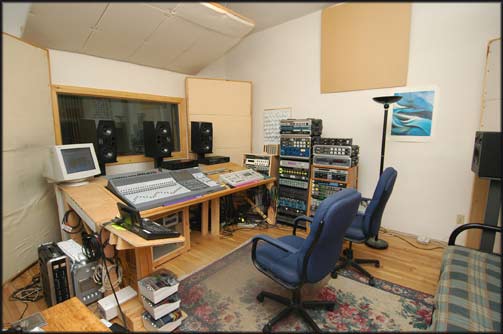Studio B at Wellspring Sound
 Studio B started back in 1997,when our then-landlord in Concord doubled the rent, ( this was the height of the late-90's high-tech boom) and threw in an 8' x 12" room with a 6' x6' closet as a consolation. At first we just used the space to repair and store stuff , but after a while we thought it'd be fun to make a little vocal overdub booth.So we put in a cheap Mackie board , a couple good mic pre's and compressors, and offered it to clients who needed a cheaper space without all the features of the A room.
Studio B started back in 1997,when our then-landlord in Concord doubled the rent, ( this was the height of the late-90's high-tech boom) and threw in an 8' x 12" room with a 6' x6' closet as a consolation. At first we just used the space to repair and store stuff , but after a while we thought it'd be fun to make a little vocal overdub booth.So we put in a cheap Mackie board , a couple good mic pre's and compressors, and offered it to clients who needed a cheaper space without all the features of the A room.
In the summer of 2023, we replaced our Sony Digital console with an all-analog 20 channel Great River Mixmaster 20 . The Mixmaster has been described sonically as a "Neve console crossed with an API" and we can't disagree. The thing has a meaty, punchy sound that these consoles are famous 4 , and it also has 4 discrete mic preamps to boot! We've been loving the new Neumann 310 powered speakers, famous for their accuracy and low ear fatigue qualities, that we recently installed as well
Studio B features a pair of ADAM S3-A monitors, a three-way powered speaker employing a unique folded ribbon tweeter. These speakers have won praise worldwide for their accuracy, long-term listenability, and wide sweet spot. Engineers who've used these monitors at Wellspring keep commenting on how well their mixes translate into other listening environments.
Even in a digitally-oriented room like Studio B, often a great piece of analog gear can do the job better. 14 channels of analog outbaord eq, including a Manley Massive Passive, a Cranesong IBIS, class A graphic and semi-parametrics by Sphere and Siemens, and some Coleman Rogers-modded Rane parametric equalizers. In addition, Studio B has plenty of premier analog compressors with 4 Distressors, a Cranesong STC-8 , and a FATSO ( literally, a "full analog tape simulation organism" - we didn't make this up!) While this parade of model numbers may seem confusing, when you hear the results, your ears will be smiling.
 Studio B's recording space is 14' x 13' and the control room is 14' x 18'. There are 12 mic lines and two stereo headhone returns betwee the two rooms, as well as dedicated speaker and guitar cable that pass beneath the floor. The console can suuport up to 48 RADAR tracks, or 32 ADAT tracks or ProTools Mix3 and 24 tracks of RADAR simultaneously. In addition to the 24 channels of mic imputs on the Sony console, Studio B has two channels of Earthworks LAB 102 mic pre's, four channels of Neve 1272's, four channels of API 3124's. a stereo Chandler TG-2, and a Univesal Audio 2610 stereo tube pre. These pres's essentially cover the range of textures desired in mic pre's, from clean to fat. All of the microphones from Studio A's mic locker are available for sessions in the B room; if conflicts arise , we've always been able to work it out.
Studio B's recording space is 14' x 13' and the control room is 14' x 18'. There are 12 mic lines and two stereo headhone returns betwee the two rooms, as well as dedicated speaker and guitar cable that pass beneath the floor. The console can suuport up to 48 RADAR tracks, or 32 ADAT tracks or ProTools Mix3 and 24 tracks of RADAR simultaneously. In addition to the 24 channels of mic imputs on the Sony console, Studio B has two channels of Earthworks LAB 102 mic pre's, four channels of Neve 1272's, four channels of API 3124's. a stereo Chandler TG-2, and a Univesal Audio 2610 stereo tube pre. These pres's essentially cover the range of textures desired in mic pre's, from clean to fat. All of the microphones from Studio A's mic locker are available for sessions in the B room; if conflicts arise , we've always been able to work it out.
Wellspring offers high quality mastering using software and outboard components by Weiss, Milab, Cranesong , Manley and others. We've mastered over 100 albums of everything from Rap and Death Metal to New Age and Classical, and we pride ourselves with the ability to produce final products that compete well in whatever marketplace they're in.
Studio B is a great room for overdubs, editing, mixing and small projects. You have access to the same great gear from studio A, and the acoustics of the room are especially suited for vocal and single-instrument overdubs. Plus , it's price is slightly less than studio. For more information about the differences between the rooms, talk to us.
Rates & Booking
Please see our Booking page for rates and information.
Please feel free to contact us at (978) 263-9246, cell phone at (978) 621-1298, or by email at eckilburn@gmail.com.
